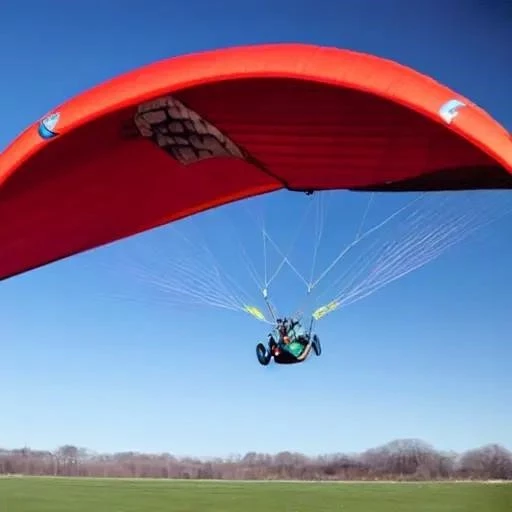
For millennia, humanity has gazed upward, captivated by the boundless expanse of the sky, dreaming of effortless flight. Today, that ancient aspiration is astonishingly accessible, thanks to innovations like the buggy powered paraglider. This unique form of ultralight aviation, blending the simplicity of a paraglider with the autonomy of an engine-driven wheeled frame, offers an unparalleled sense of freedom. Yet, for many, the exhilarating prospect is often shadowed by a fundamental question: just how safe are these incredible flying machines?
Often referred to as paramotor trikes or simply “TrikeBuggy,” these devices represent a fascinating evolution in personal flight. Unlike traditional paramotoring where the engine is worn as a backpack, the buggy variant provides a seated, often more comfortable experience, particularly favored by those seeking extended flight times or carrying heavier loads. By integrating insights from evolving aviation technology and robust engineering, modern buggy powered paragliders are remarkably designed for both stability and performance, truly democratizing the skies for a new generation of adventurers.
The distinction between unpowered paragliding and its motorized cousin is crucial, primarily due to the addition of an engine. This fundamental difference naturally leads to varying operational dynamics and, consequently, unique safety considerations. While accidents, often dramatic, do occur and frequently make headlines – from emergency landings in trees to unfortunate encounters with power lines – these incidents, when examined closely, typically underscore the critical importance of pilot proficiency, meticulous equipment maintenance, and an unwavering respect for environmental conditions. It’s a sport where preparedness is paramount, transforming potential peril into managed risk.
Essential Safety Considerations for Buggy Powered Paragliding
| Safety Aspect | Description | Importance for Pilot Safety | Reference/Resource |
|---|---|---|---|
| Comprehensive Training & Certification | Structured flight instruction from a certified instructor, covering theory, ground handling, and flight maneuvers. | Minimizes pilot error, builds essential skills, and fosters safe decision-making. Essential for understanding aerodynamics and emergency procedures. | United States Powered Paragliding Association (USPPA) |
| Pre-Flight Inspections | Thorough check of wing, lines, carabiners, motor, fuel, and trike frame before every flight. | Detects wear, damage, or loose components that could lead to in-flight failure, ensuring equipment integrity. | Manufacturer’s Manuals, BlackHawk Paramotor safety guides |
| Weather Awareness | Understanding and monitoring local weather patterns, wind speeds, thermals, and atmospheric stability. | Prevents flying in hazardous conditions (e.g., strong winds, turbulence, storms) that can quickly overwhelm pilot control. | Aviation Weather Forecasts, Local Flight Schools |
| Appropriate Equipment | Using certified, well-maintained equipment suitable for the pilot’s weight and skill level, including a proper helmet. | Provides inherent stability and performance margins, maximizing passive safety features of the wing and motor system. | Reputable Gear Manufacturers (e.g., TrikeBuggy, SkyRunner), Dealer Recommendations |
| Active Flying Techniques | Proactive pilot input to maintain wing control and stability, especially in turbulent air. | Significantly increases the safety margin against wing collapses and allows pilots to react effectively to changing air conditions. | Advanced Training Courses, Experienced Pilot Mentorship |
Indeed, expert opinions widely affirm that buggy powered paragliding, when approached with due diligence, is remarkably safe. “Believe it or not,” one industry veteran states, “it is one of the safest aviation sports out there, provided you get proper training and fly within sensible parameters.” This sentiment is echoed by data suggesting that PPG can even be statistically safer than activities like motorcycle riding, highlighting the importance of context and individual responsibility. The inherent stability of a modern paraglider wing, coupled with the engine’s ability to provide autonomy and freedom, creates a uniquely forgiving platform, especially for beginners utilizing reflex gliders designed for increased passive safety.
Technological advancements have played a pivotal role in enhancing the safety profile of these aerial chariots. Contemporary wings boast incredible resistance to collapse, often self-recovering with minimal pilot input. Manufacturers like BlackHawk and TrikeBuggy continuously innovate, developing lighter, stronger materials and more reliable engines. The SkyRunner, a pioneering flying dune buggy, exemplifies this fusion of robust ground vehicle design with cutting-edge flight capabilities, pushing the boundaries of what’s possible in personal aviation while prioritizing safety.
However, the human element remains the most critical factor. While the FAA in the United States currently does not heavily regulate paramotoring, emphasizing individual responsibility, the community itself has established strong self-regulatory practices. Organizations like the USPPA (United States Powered Paragliding Association) champion comprehensive training programs, advocating for pilot proficiency equivalent to that of a Basic Flight Instructor (BFI) for advanced setups like the TrikeBuggy. This commitment to education ensures that aspiring pilots are thoroughly versed in aerodynamics, weather interpretation, and emergency procedures, transforming potential novices into confident, capable aviators.
Looking ahead, the future of buggy powered paragliding appears incredibly bright. As technology continues its relentless march forward, we can anticipate even lighter, more fuel-efficient engines, sophisticated onboard navigation, and potentially integrated collision avoidance systems. The allure of soaring above landscapes, experiencing the world from a truly unique vantage point, will only grow. By embracing rigorous training, performing diligent pre-flight checks, and respecting the immutable laws of physics and meteorology, pilots can confidently unlock the extraordinary potential of these machines, transforming the dream of flight into a safe, exhilarating reality.
The sky is not the limit; it’s just the beginning. With continuous innovation and an unwavering commitment to safety, buggy powered paragliders are poised to redefine personal aviation, inviting more adventurers to experience the serene thrill of flight, securely and joyfully.
